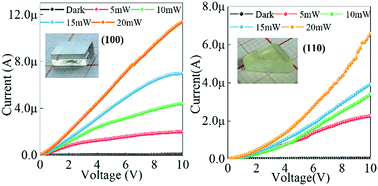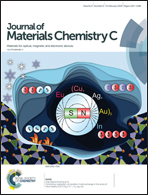Crystal orientation-dependent optoelectronic properties of MAPbCl3 single crystals†
Abstract
Hybrid perovskite MAPbCl3 is considered to be one of the most promising candidates applied in visible-blind UV-photo-detectors due to its outstanding optoelectronic properties. It is proved that the MAPbCl3 single crystal is more excellent than its polycrystalline counterpart because of its fewer defects and grain boundaries. When referring to a single crystal, the crystal orientation or crystal structure anisotropy is an inevitable topic, because structure anisotropy can affect or decide the optoelectronic properties of single crystals. In this study, both cubic and triangular prism MAPbCl3 single crystals with (100) and (110) crystallographic planes were successfully grown from mixed solutions. The crystal growth process, crystal structure and optical absorption were investigated. Moreover, by fabricating metal–semiconductor–metal (MSM) photo-detectors using Au interdigital electrodes on both (100) and (110) planes, the optoelectronic anisotropy was explored by comparing photocurrents, responsivity, external quantum efficiency and detectivity. According to the crystal structure and calculated charge density, the optoelectronic anisotropy in the MAPbCl3 single crystal was revealed.



 Please wait while we load your content...
Please wait while we load your content...